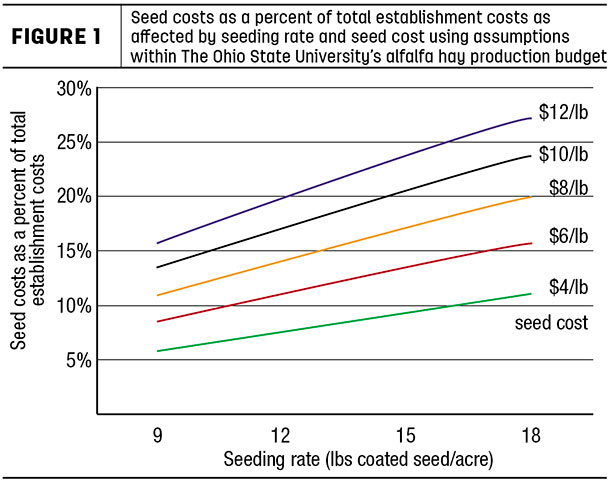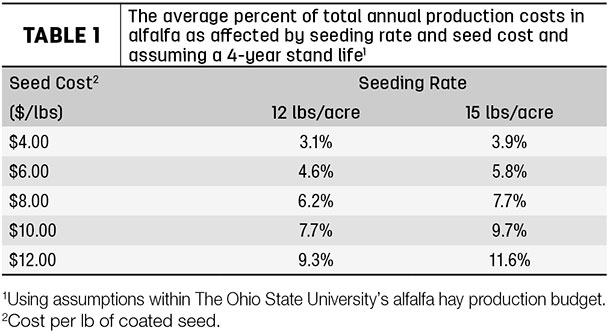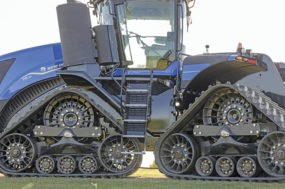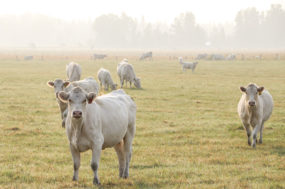Extension agronomists take variety recommendations seriously. We each have digital reams of data that examine the yield and animal performance improvements that support those variety recommendations. We can prove even if the differences are seemingly marginal, they add up to greater profitability.
Nowhere is this more prevalent than in the case of genetically modified varieties of alfalfa. Most alfalfa growers are accustomed to seeing $3.75 to $4.50 per pound prices. The addition of the $140 to $300 per bag technology fees that are tacked on to the sticker price for Roundup Ready or HarvXtra reduced-lignin traits have turned people off. There are certainly some situations where these traits would not be cost-effective, but the cost-benefit analyses for these traits have generally shown them to be profitable despite higher seed costs.
If we take it as a given that these traits are cost-effective, the question then becomes “Can the seeding rates be reduced?” This is a little harder to answer. Most of the research that has measured yield response to seeding rates was done at least 25 years ago. Much of that research rarely showed an improvement in yield above 10 to 12 pounds of alfalfa seed per acre. But that was small-plot research under consistently good conditions using precise equipment. So university extension agronomists were conservative and added a “fudge factor.” As a result, most states have seeding rate recommendations of 15 to 20 pounds per acre for alfalfa.
A lot has changed in the decades since those seeding rate recommendations were set. Land preparation methods are better; planting equipment is more precise; seed quality has improved; and seed coatings and treatments have increased seedling survival. Though these seeding rate studies have not been repeated recently, there is an assumption that these advances vastly increase the likelihood of successful establishment, even with lower rates of pure live seed to the acre.

However, one should really examine the impact of seed costs on their total costs before reducing seeding rates. For example, I compared the total costs of establishment using The Ohio State University’s alfalfa hay production budget. I assumed that all the other factors listed in that enterprise budget reflected current practices and prices. Thus, I only changed the seed costs to calculate the impact of $4, $6, $8, $10 and $12 per pound of seed on total establishment costs (see Figure 1). When expressed as a percent of establishment costs, seed costs are clearly important. But when those costs are amortized over the life of the stand, which was assumed to be four years in the case of the OSU budget, the seed costs represent relatively little of the total annual costs of production (see Table 1). A 3 pound per acre reduction in seed costs had only a marginal impact on the total cost of production each year.

Most agronomists agree that alfalfa seeding rates can be reduced to 12 to 15 pounds per acre with minimal risk of yield loss. However, we also generally agree that the seeding rates should not be lowered below 12 to 15 pounds per acre because the risk of yield loss is too great. Let’s examine the idea of dropping the seeding rate by 3 pounds per acre. Even assuming the grower pays the full sticker price of $11.50 per pound for the two GM-trait alfalfa, a 3-pound reduction in seeding rate only saves $8.63 per acre per year if the establishment cost is amortized over a four-year stand life [($11.50 x 3 pounds)/4 years]. If the alfalfa forage is conservatively worth $150 per ton, any yield reduction greater than 115 pounds per acre per year would cause the seed cost savings to be uneconomical. So is it really worth the risk of reducing the seeding rate another 3 pounds? ![]()

-
Dennis Hancock
- Associate Professor
- Extension Forage Agronomist - University of Georgia
- Email Dennis Hancock










